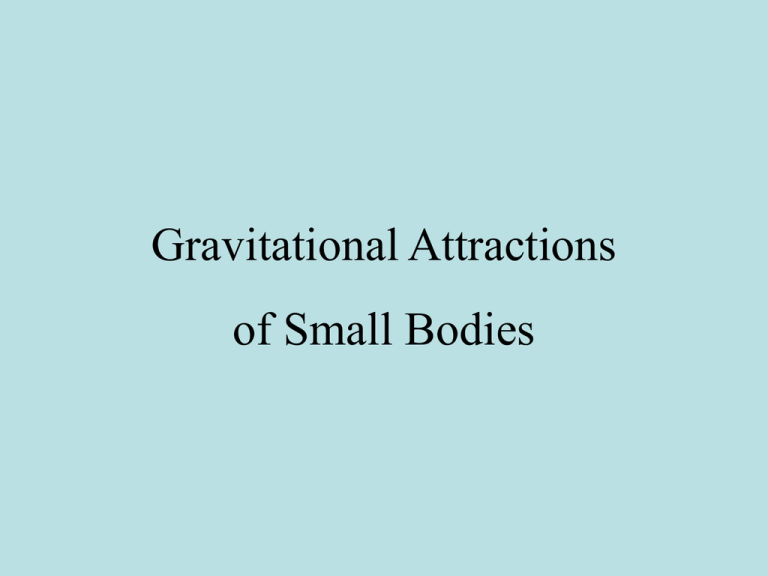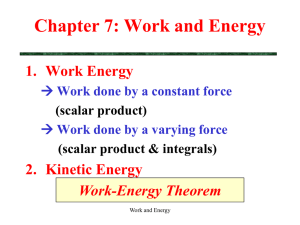Document
advertisement

Gravitational Attractions of Small Bodies Calculating the gravitational attraction of an arbitrary body Given an elementary body with mass mi at position ri, the associated acceleration gi at any point r is gi (r ) Gmi ri 3 (r ri ) Forces add linearly, so the total acceleration due to a group of n bodies is n gi (r ) G i 1 Where mi = (ri)vi. mi ri 3 n (r ri ) G i 1 (ri ) ri 3 (r ri )vi For a continuous mass, let vi go to zero and the sum becomes an integral: gi (r ) G (r')(r r ') V (r r ') 3 dv(r ') Thus, given the density distribution (r’), you can calculate the gravitational acceleration. Two practical comments: 1. Usually we try to take advantage of any symmetry, to make the vector addition easier. 2. Potential is often easier to work with because it is a scalar. Specifically: U(r ) G V (r')dv(r ') (r r ') In practice, we measure |g| as opposed to the vector quantity itself. Suppose we are measuring the gravitational anomaly caused by a small body within the Earth. Let ge be the acceleration of the Earth without the body, and Dg be the perturbation due to the anomalous mass (Dg << ge). Then, the total field is found from g ge Dg g g Dg g Dg 1/ 2 e e ge ge 2ge Dg Dge Dg 1/ 2 1/ 2 2 Dge g Dg e g ge 1 2 2 2 ge ge Expanding (as (1+x)1/2 ~ 1 + x/2) we get: 2 Dg cos Dg g Dg g Dg e ge 1 e 2 ge 1 g ge 1 e 2 ge Dg cos 2 ge ge 2 ge ge Or, since Dgcos is the z component of Dg: g ge Dg cos ge Dg z The residual R is therefore R g ge Dg z Therefore, in calculating the anomaly due to a body, we only worry about the z component. We will now demonstrate how to calculate the gravity anomaly due to bodies with simple shapes. Calcuation of Dg for some simple bodies 1. Sphere of constant density . An example of using the potential U. Recall that U(r ) G (r')dv(r ') V (r r ') In this example, (r’) = constant = o. For a sphere, dv(r’) = r’2sinddfdr’ Using the law of cosines, |r - r’| = [r2 + r’2 - 2rr’cos]1/2. Thus U(r ) G o V r r '2 sindr 'ddf 2 r ' 2rr 'cos 2 a 1/ 2 G o r ' dr ' 2 0 0 r The last integral is just 2. Note that 1/ 2 2a bx dx a bx 1/ 2 b 2 sinddf 2 r ' 2rr 'cos 2 1/ 2 df 0 Substitute x = cos and dx = -sind in the above and we get a U(r ) 2G o 0 a 1/ 2 r '2 dr ' 2 r '2 dr ' 2 2 r r ' 2rr 'cos 2 G r r ' o rr ' rr ' 0 0 1/ 2 2 1/ 2 r r ' Now consider the case where r > r’ (outside the sphere): a U(r ) 2Go 0 a r'2 dr' r'2 dr' 4 Ga 3 o GM r r' r r' 4 Go rr' r 3r r 0 Which is the same as the potential for a point mass. Thus U GM GMz GMz gz 2 2 2 3/ 2 3 2 2 2 1/ 2 z z (x y z ) (x y z ) r Now consider the case where r < r’ (inside the sphere): r a r '2 dr' r '2 dr' U(r ) 2G o r r ' r r' r r ' r' r rr ' rr ' 0 r r 2r '2 dr' a 2 r 2 U(r ) 2G o 2r'dr' 2Go a r 3 0 r Thus U 4 G o r 3 GM r g 2 2 r 3 r r Meaning that only the mass within the radius r contributes to the acceleration. A Buried Vertical Cylinder. An Example of Using Symmetry. Let’s try computing the anomaly due to a vertical cylinder within the earth at a point directly above the center of the cylinder. Consider a cylinder of radius a buried in the earth at a depth h1. The cylinder extends to depth h2. It has a density 2, while the surrounding earth has a density 1 (so D = 2 - 1). Horizontal (sin) attractions cancel because of symmetry. The remaining vertical (cos) gravitational anomaly caused by a volume element is GD gz R 2 For a cylinder, dv = rdrdzdf. Also, cos = z/(r2 + z2)1/2. Therefore GD zrdrdzdf gz 2 2 r z r 2 z 21/ 2 cosdv 2 h2 a Dgz GD df zdz 0 h1 0 h2 rdr r 2 z 2 3/ 2 a 2GD zdz h1 0 rdr r 2 z 1 1 2GDh h Dgz 2GD zdz 2 1 1/ 2 2 2 z h1 a z 2 1/ 2 2 1/ 2 2 2 Dgz 2GDh2 h1 a h2 a h1 h2 h2 h1 2 3/ 2 1/ 2 a 2 z 2 zdz If we let a become very large, the the equation above reduces to Dgz 2GDh2 h1 2GDDh This will turn out to be a very useful equation later on, so remember it! Anomalies from Two-Dimensional Structures Very often it is useful to treat structures in the Earth as twodimensional. It turns out there are clever ways to analyze gravity anomalies from such structures. Here is how you can do it: For a 2-D structure, r = r(x’, z’) (i.e., no y dependence). In what follows, we use primed coordinates (x’, y’, z’) for the anomalous mass, and unprimed coordinates (x, y, z) for the observing station. All measurements are made along the y = 0 axis. The distance R in the x-z plane is R2 = (x-x’)2 + (z-z’)2 And the total distance r is r2 = R2 + y’2 The gravitational potential is U(x,y,z) G (x',z')dx'dy'dz' r L dy' 2 2 1/ 2 L (R y' ) G (x',z')dx'dz' The integral over y’ is now finite. Later we will let it get big. For now U(x,y,z) G (x',z ')dx'dz' ln y' (R y' ) U(x,y,z) G (x',z ')dx'dz' ln 2 2 L L (R 2 L2 ) L (R 2 L2 ) L Here comes cute trick #1. Because we are really interested in g and not U, and because g = U, we can add anything we want to U that is not a function of (x,y,z) without affecting g. So, let’s define a constant: Uo G (R 2 L2 ) L (x',z')dx'dz' ln o2 2 (Ro L ) L Then U U Uo G If we let L >> R, then logarithm becomes: 2 2 2 (Ro L2 ) L (R L ) L (x',z')dx'dz' ln 2 2 2 2 (Ro L ) L (R L ) L 2 R (R2 L2 ) L1 2 . The argument in the 2L 2 R 2 R 2 R2 Ro 2 2L Ro o 2 R 2 o 2L 2L 4L ln ln ln 2ln(Ro) ln(R) 2 2 2 2 2 Ro R 2 Ro R R 2L R 2L 2L 4L2 So U 2G (x',z')ln(Ro) ln(R)dx'dz' And gz U (x',z')(z z') 2G dx'dz' 2 2 z (x x') (z z') The integral for g is often easy to integrate. In many applications we can assume (x’,z’) = constant and we set z = 0 at the surface. Now comes cute trick #2: let’s use cylindrical coordinates instead of Cartesian. Then 2 2 2 R (x x') (z z ') dx'dz' RdRd Substituting these expressions into the formula for gz gives Noting that (z z') sin R gz 2G RdRd (z z') R2 we have gz 2G sinddR Fora given value of , the limits of integration are from R() near to the observer to R() from from the observer. We perform this kind of integration from at the top of the body (top) to at the bottom (bottom). Noting that sindR = dz, we have gz 2G ddz 2G bottom z( ) far bottom d dz 2G d z( ) far top z( ) close top z( )close These two integrals are line integrals that together encompass the body (the minus sign on the second integral reverses the direction. Therefore gz 2G z( )d Which is a line integral around the body. This is a great way to compute anomalies for complicated structures. Note that the line integration must always be done in a clockwise sense! Let’s use this method to calculate the attractions of some simple bodies. The Infinite Sheet (Revisited) In this case 2 3 4 1 1 2 3 4 z( )d z( )d z( )d z( )d z( )d 0 z 2( ) 0 z 2 ( ) gz 2G z( )d 2G (z2 z1) 2Gh Which is what we obtained before (but with much more work!) The Semi-Infinite Sheet of Thickness t As above 2 3 4 1 1 2 3 4 z( )d z( )d z( )d z( )d z( )d z1 o 0 z1 t o 0 ot gz 2G z( )d 2G ot Now o So x -> ∞ Also x arctan 2 zo x gz 2Gt arctan z o 2 Note that as -> g -> 2Gt (i.e., infinite slab) x -> 0 -> /2 g -> Gt x -> -∞ -> 0 g -> 0 dgz d arctanx z o dx 2Gt dx z o 2Gt 2 2 x z o 2Gt dx x 0 zo dgz Thus, the slope lessens as the depth of the sheet increases. In fact, the slope can give us some information about the depth of the sheet. Hitchhiker’s Guide to Gravity First, since many situations use the infinite slab formula, it’s useful to remember that if the density difference D is given in gr/cm3 and the thickness of the slab Dh is given in kilometers, then g in mgals is g = 2GDDh = 2 x 3.14159 x 6.67DDh = 41.9DDh ~ 42 DDh So, if you can remember the answer to Life, the Universe, and Everything, you can remember to how to calculate the infinite slab attraction! Practical example #1: A basin filled with sediments Let’s suppose we are standing on top of a basin that is 2 km thick and filled the sediments with a density that is 0.5 gr/cm3 less than the basement below, we would expect that in the middle of the basin: Dgmid = 42 x 2 x 0.5 = 42 mgals At the edge of the basin (x=0), Dgx=0 = Dgmid/2 = 21 mgals and dg/dx = (2G DDh/zo)=13.34 mgals/km (note zo = 1 km) Practical example #2: The continental margin In this case, we can think of a margin as two semi-infinite slabs on either side of an infinite slab that has a thickness equal to the ocean side of the margin. The upper semi-∞ slab make a D>0 contribution, while the lower semi-∞ slab make a D<0 contribution. BUT, the contributions don’t cancel because they are at different depths. Example of Equivalence and Non-uniqueness Convince yourself that the 3 geometries shown to the right give identical relative gravity anomalies: Identical Response from different Mass Distributions








